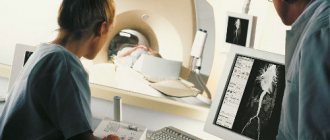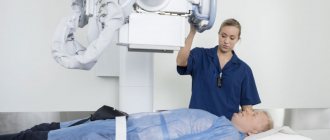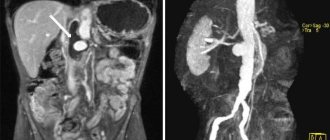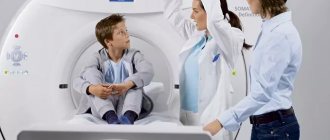- Which abdominal organs are within the range of vision of a magnetic tomograph?
- Advantages of the method
- Abdominal check-up: is it necessary or not?
- Dangerous "finds"
Pain, colic, bloating, nausea, belching, heaviness after eating, taste in the mouth, constipation or diarrhea - such diverse manifestations of diseases of organs located in the abdominal cavity can be. They occupy a small space and are located very close to each other. Therefore, often the patient cannot explain where exactly it hurts, and the doctor cannot determine what the problem is. In such cases, it is recommended to do an MRI of the abdominal cavity. Diagnostics always allows you to determine the cause of concern, and often also presents “surprises”. That is, it shows diseases that do not yet have clinical manifestations.
Types of abdominal MRI
When referring for an MRI, the doctor determines what type of study will be chosen for diagnosis. The following MRI options are available:
- extensive overview;
- with or without the use of a contrast agent;
- angiography.
Most often, doctors prescribe an extensive examination of the abdominal cavity on a tomograph, as it allows one to assess the condition of the following group of organs:
- soft tissues;
- gastrointestinal tract;
- kidneys and adrenal glands;
- spleen;
- liver;
- lymph nodes;
- bile ducts;
- pancreas;
- veins and arteries located in the studied part of the body.
MRI diagnostics allows not only to assess the condition of the organs being examined, but also to see how negative the impact of the pathological process is on the organs and tissues located “in the neighborhood.”
Abdominal check-up: is it necessary or not?
The now fashionable Check-up medical service is actually not a new thing at all. This is a planned preventive examination, which we used to call medical examinations. The Check-up program may include various types of diagnostics, including MRI of the peritoneum and retroperitoneal space. Is it necessary to undergo it if you feel absolutely healthy, have no bad habits, have good heredity, and eat right? Yes, definitely.
More than 95% of the adult population have gastrointestinal diseases. Gastritis, reflux disease, stones in the gall bladder or ducts, pancreatitis of the pancreas, fatty liver hepatosis, benign tumors, cancer - these are just some of the possible pathologies that can develop in anyone, and are often not associated with heredity or lifestyle.
What diseases can be detected on an MRI of the abdominal organs?
The magnetic resonance imaging procedure consists of layer-by-layer scanning of a certain area of the body in order to identify pathological processes and anomalies. Based on three-dimensional images and a conclusion, the attending physician will make a diagnosis. MRI of the abdominal organs shows the following diseases and abnormalities:
- abnormal development of abdominal organs from birth;
- disturbances in the structure of nerve trunks;
- inflammatory processes;
- cystic formations;
- cirrhosis of the liver;
- the presence of malignant tumors;
- spread of metastases;
- formation of stones in the bile ducts;
- circulatory problems and vascular disorders (thrombosis or aneurysm).

In addition, using images, the doctor determines the structure and size of the organs being examined.
Is it possible to do an MRI of the stomach?
Magnetic resonance imaging is one of the safest hardware diagnostic methods. An MRI of the stomach can be done in cases where the patient has contraindications to other types of instrumental studies (CT, X-ray, FGDS).
Limitations to the use of magnetic resonance imaging are associated with the physical properties of the induction field. MRI is not prescribed:
- if you have implanted electronic devices (pacemakers, etc.);
- in the presence of metal fixed structures (knitting needles, prostheses, pins, etc.);
- patients with breast implants containing magnetic guides;
- people with tattoos made with metal-containing inks.
When choosing a hardware diagnostic method, you should remember that the stomach is a hollow organ that performs motor and secretory functions. In this regard, it is almost impossible to record the reaction of tissues to the directed action of an electromagnetic field.
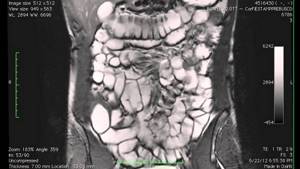
Magnetic resonance imaging of the intestine
Do they do MRI of the stomach? The study is possible with double contrast. To maintain the walls of the organ in a stretched state, a special liquid is used that fills the stomach cavity. The introduction of a gadolinium solution into the vascular bed helps to visualize the structure of the mucous membrane and smooth muscles.
Hydro-MRI of the stomach allows you to identify:
- internal bleeding;
- inflammatory conditions of the mucous membrane;
- benign and malignant neoplasms;
- violation of the integrity of the mucous membrane and walls of the stomach;
- anomalies in the structure of the organ;
- Crohn's disease.
The native procedure poorly shows the condition of the stomach, small and large intestines, and therefore is rarely used in the diagnosis of gastrointestinal diseases.
Reasons for referral for abdominal MRI
A referral for an MRI is issued by a doctor if a controversial situation arises, it is impossible to make an accurate diagnosis, or if it is necessary to urgently determine the source of the disease. Repeated tests may also be ordered to monitor the condition of the organ after surgery or a course of treatment (for example, chemotherapy). In this case, the MRI images will be compared with the previous study result to identify the dynamics of the disease.
The key reasons for referral for abdominal MRI are:
- suspicion of the presence of neoplasms to determine the type: malignant or benign;
- abdominal injury;
- confirmation of abnormal development of abdominal organs;
- search for the source of the inflammatory process;
- confirmation of the results of previous diagnostic procedures if the diagnosis has not been made definitively (ultrasound diagnostics, computed tomography, radiography);
- if internal bleeding is suspected;
- searching for spread or absence of metastases;
- gallbladder diseases (obstructive jaundice);
- inspection of the volume of fluid accumulation in the peritoneal area;
- determination of the stage of development of pancreatitis (acute or chronic);
- changes in the structure of organs or soft tissues of an ischemic nature;
- increased size of the spleen, gallbladder, lymph nodes or liver;
- to monitor the condition of the abdominal cavity after surgery;
- in order to confirm or reject the chosen treatment regimen.
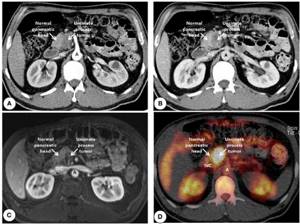
The magnetic resonance imaging procedure is also prescribed when it is impossible or it has been proven that other types of diagnostic testing are ineffective. For example, to identify stones in the bile ducts, it is better to do a computed tomography scan, since this type of procedure gives clearer pictures of bone structures. MRI is aimed at “transilluminating” soft tissues. Therefore, only a doctor can determine which diagnostic method should be used.
How is an MRI of the stomach done?
MRI scanning is carried out using a device consisting of a mobile table (conveyor) and a wide closed part (pipe or tunnel). The device contains sensors that read the signal from the tissues being studied. The electromagnetic field is generated by a special device located inside the tomograph tube.
The patient is positioned face up on the table, and the body is secured using fasteners and bolsters to prevent accidental movements. The patient has an alarm button in his hand, and communication with medical staff is maintained through an intercom. Special headphones provide protection from the noise of the operating device. During an MRI, the doctor and x-ray technician move to an adjacent room, from where they monitor the examination process.
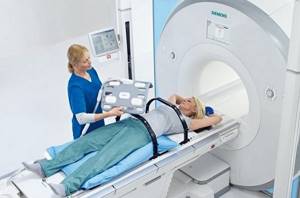
Closed MRI machine
The table with the subject being examined is rolled into the tomograph tunnel. The abdominal cavity is scanned in sagittal, axial and frontal projections. As a result of magnetic resonance imaging, the doctor receives photos of thin sections of the area being studied. If necessary, based on layer-by-layer images, a three-dimensional image of the anatomical formation in question is created.
Scanning the gastrointestinal tract has a number of features. Due to the low information content of the native procedure, MRI of the stomach and intestines is done with double contrast enhancement. Before the study, the patient drinks up to a liter of two-phase liquid for an hour, the doctor uses medications that slow down the absorption process of the solution. The walls of the stomach are stretched and are in this state during the scan.
Additionally, a catheter connected to an automatic injector is placed in the patient’s vein. The contrast solution is administered at a constant rate (bolus enhancement). The solution fills the lumen of blood vessels and the intercellular space, visualizing the characteristics of the blood supply and changes in the structure of the stomach walls.
The procedure takes up to 40 minutes. It is important to maintain your original body position until the end of the scan. Random movements lead to defects in images. The patient receives the results of the study 15-20 minutes after the end of the session.
Who should not undergo an MRI?
Despite the safety of examination using a magnetic resonance imaging scanner, there are restrictions or complete prohibitions on the procedure. A complete ban on undergoing MRI includes:
- the presence of implants containing metal compounds (cochlear implant, pacemaker, mechanical heart valve);
- the presence in the body of foreign objects with a metal base or inclusions (bullets, fragments);
- presence of tattoos using paint with metals;
- pregnancy period (1st trimester);
- the patient’s condition when artificial life support is required (resuscitation, coma);
- large body weight (more than 120 kg).

The reason for the prohibition of undergoing examination if a patient has permanent metal implants and tattoos on the body is due to the fact that these objects under the influence of the magnetic field of the tomograph can heat up, expand and even move slightly. This situation can bring not only pain, but also injury. Electronic items and metal implants may fail.
It is not a contraindication for magnetic resonance imaging if the patient has dentures or modern braces, as well as titanium implants.
Pregnant patients are prohibited from undergoing the procedure in the 1st trimester, because there is no collected information about the harm or safety of the examination for the correct formation of the fetus.
In some cases, undergoing a magnetic resonance examination is extremely important for the patient's life. According to the doctor's decision, if categorical reasons for refusing the procedure are not found, magnetic resonance imaging can be performed.
It is not advisable to undergo a tomography examination if the following circumstances exist:
- period of breastfeeding and pregnancy (if a contrast agent is used);
- allergy to gadolinium metals included in the contrast agent (extremely rare);
- diagnosed renal or liver failure;
- inability to keep the body still (in some cases, the doctor may suggest medication to induce sleep);
- the presence of mental disorders, acute fears and panic attacks associated with being in the “tunnel” of a tomograph (in this case, you can try to undergo research using open machines);
- severe pain that does not allow you to lie still on the medical table at the time of scanning (the doctor may suggest taking painkillers).
Preparation and conduct of the study
On the day of the procedure, you must arrive at the clinic in advance: paperwork will take some time. You need to take with you your passport, the results of previous studies (if available), certificates that may be important for the study.
The patient removes all jewelry and other objects made of metal, and then lies on the tomograph platform, lying on his back. Legs and arms are fixed to prevent involuntary movements. When conducting a contrast study, a special substance is injected into a vein.
The platform slides into a device that forms a magnetic field, takes pictures, and transfers them to a computer. After processing the information, three-dimensional images are obtained. After studying them, the doctor writes a conclusion and transfers it to the patient along with the images and recording on electronic media.
Based on the specifics of the procedure, a necessary part of preparation is a psychological attitude. To begin with, it is advisable to study information about how the study is carried out. It is important to remember that the device makes noise, but to reduce its level, the patient is given headphones or earplugs.
The reliability of the results largely depends on the quality of preparation for the study.
They are informative, so this issue should be taken seriously. Rate this article: (1 rated 5 out of 5)
Rules for preparing for an MRI of the abdominal cavity
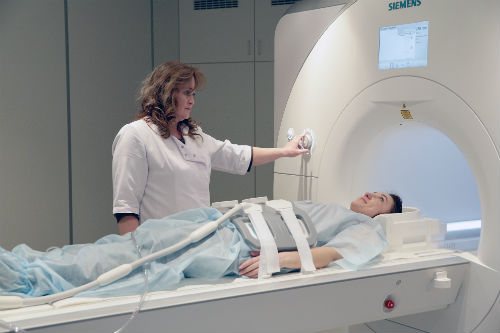
Magnetic resonance imaging is usually performed without prior preparation. However, when the procedure involves the abdominal region, the following preparatory measures should be observed:
- Avoid increased gas formation with a special diet. A few days before the study, it is necessary to exclude the following foods: brown bread, confectionery sweets, fresh vegetables and fruits, legumes, dairy products and alcoholic beverages.
- 2-3 days before an MRI of the abdominal cavity, you must stop taking medications that contribute to the formation of gases in the intestines (for example, Duphalac).
- If before the examination the patient feels that the accumulation of gases could not be avoided, it is necessary to take a carminative (for example, Espumisan).
- It is advisable to go on a low-carbohydrate diet to relieve the work of the liver, pancreas and spleen for several days.
- If you suspect you have an allergic reaction to gadolinium, you can take a challenge test before the test.
- If you complain of persistent constipation, you can take a laxative or do an enema to cleanse the intestines before the MRI.
- If magnetic resonance imaging using a contrast agent is planned, and the patient is a breastfeeding woman, breast milk should be expressed into special storage bags and placed in the freezer 2 days before the examination. After the contrast study, you should not breastfeed the baby for 2 days, and simply express the milk.
- If the patient has abnormalities associated with the inability to control body movements, it is necessary to warn the doctor about this. Perhaps the procedure will be carried out by putting the patient into medicated sleep.
- If you feel excessive anxiety, a panic attack or fear occurs, you can take sedatives. However, this information should be disclosed to the doctor.
- Before performing an MRI of the abdominal organs, you must stop eating 6 hours before the examination, and drink water 4 hours before the examination. You should not drink carbonated water, coffee or tea on the day of the test.
- An MRI should take the results of previous examinations, if any.
Gas-forming foods before MRI

Excessive accumulation of gases is facilitated by the consumption of certain foods and aerophagia (systematic swallowing of air)
From a physiological point of view, the presence of gases in the human intestines is normal. They occur due to swallowed air (during hasty eating, the habit of talking at the table, smoking, chewing gum, etc.), during the digestion of food and as a result of the activity of bacteria. With errors in nutrition and disturbances in the gastrointestinal tract, flatulence is observed, expressed in bloating, belching and a feeling of discomfort in the abdominal cavity. This pathology may interfere with the examination. Therefore, two days before diagnosis, they begin a diet with the exclusion of gas-forming foods (before MRI, it is necessary to reduce the intensity of fermentation processes as much as possible).
Procedure for performing an MRI of the abdominal organs
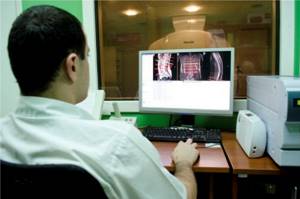
MRI of the abdominal cavity is carried out in the following order:
- The patient must remove all parts containing metallic compounds before entering the X-ray room. They can be both on clothes and on the patient’s body. Electronic gadgets and bank cards should also be left outside the office, otherwise they may distort the tomography results.
- Before starting the procedure, the doctor will interview the patient, study the existing medical history and photographs. The patient is required to fill out a consent form for tomography.
- The patient lies down on the medical table, and the medical staff uses special straps to secure the body. The table is placed in the tomograph and the machine is started. The equipment makes a lot of noise during scanning. Before the examination begins, the patient may wear earplugs. If he feels any discomfort or severe anxiety, he can contact the doctor through a special microphone located inside the tomograph.
- The doctor, being in the next office, monitors the patient through glass and receives images of organs in a three-dimensional projection on a computer monitor. The images are processed by the program, and the doctor records images that show abnormalities. Magnetic resonance imaging of the abdomen lasts from 30 to 50 minutes.
- A few hours after the end of the study, the doctor issues a conclusion, which the patient must show to the attending doctor. After this, a final diagnosis will be made.
Magnetic resonance imaging procedure with contrast
Assessment of the condition of organs located in the abdominal cavity is most often carried out using magnetic resonance imaging using a contrast agent. In this way, the path of blood circulation, the condition of blood vessels, as well as the presence of malignant neoplasms and metastases can be seen as clearly as possible on the monitor screen.
The contrast agent contains gadolinium metals, which are practically hypoallergenic and do not cause an allergic reaction in the patient, unlike iodine during computed tomography.
Medicines before the procedure
When preparing for an abdominal MRI, you should consult with your doctor about taking medications. If the patient is undergoing long-term drug treatment, most medications are taken as usual. But there may be exceptions.
To conduct MRI in people with chronic constipation and flatulence, sorbents or antispasmodics, enzymes, and drugs that prevent bloating may be prescribed. Cleansing with an enema is also discussed with the doctor. In the presence of certain pathologies, such a procedure can be harmful because it stretches the intestinal walls.
Is it safe to have an MRI?
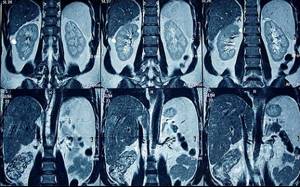
The magnetic resonance imaging procedure is recognized as the safest diagnostic method, given that the magnetic field induction is no more than 1.5 Tesla. The study does not use X-rays and the patient does not receive radiation exposure. Unlike computed tomography, MRI can be performed repeatedly, without restrictions and without maintaining certain intervals between procedures.
If we consider MRI using a contrast agent, then the level of safety here is also quite high. The contrast is based on gadolinium, which causes an allergic reaction in extremely rare cases. The substance does not harm the patient's health.
Contraindications to the procedure: what you should tell your doctor before the test
Before prescribing an MRI procedure, you should analyze the list of contraindications for compliance with your own situation. It is prohibited to conduct research if there are metal objects in the body:
- pacemaker;
- artificial joints made of ferromagnetic alloys;
- intracardiac valves and stents installed less than 4-6 months ago;
- the presence of tattoos on the skin with metal-containing coloring elements.
Tomography is prohibited in the first trimester of pregnancy, but if there is an emergency, a specialist has the right to prescribe a study in a hospital setting.
MRI with gadolinium contrast should only be performed after individual tolerance to the drug has been confirmed. If the treatment process requires hemodialysis, the study is also postponed or carried out in agreement with the nephrologist.
Doctor diagnosing abdominal diseases

Doctors of different specialties can write out a referral for a magnetic resonance imaging procedure based on the indications and symptoms: general practitioner, oncologist, gastroenterologist, surgeon, urologist.
Timely examination of the abdominal cavity allows you to detect the disease in the early stages, when treatment will be most effective, and the pathological abnormality has not yet had time to cause serious damage to health.
You can find a suitable clinical diagnostic center on our website, where brief reviews of clinics performing magnetic resonance imaging procedures are presented. On your own or with the help of a specialist, you can sign up for a free MRI at a low price, and also receive a discount on your first appointment.
How to prepare for an MRI examination?
This procedure does not require special preparation. Your doctor will recommend that you stop eating and drinking immediately before the test. To obtain the most accurate result, it is recommended to limit yourself in the consumption of tea, coffee and flour products a few days before the procedure. The tomograph creates a special magnetized field, as a result of which before the procedure it is necessary to remove jewelry and metal objects, glasses, piercings, watches, belts, remove your mobile phone, flash cards, coins, bank and transport cards from your pockets. Females are advised to limit themselves to minimal makeup, as some products contain metal particles.
Carrying out the procedure
Before starting the procedure, the doctor explains the entire examination process to the patient, talks about the rules and contraindications. Next, the patient lies down on a special table, which then smoothly moves into the tomograph. To obtain the most accurate results, you should remain calm and still. Often, during the examination, the stomach walls are straightened by slightly stretching with the help of an iron-containing solution, which is prescribed to the patient and relieves pain. Sometimes a specialist administers intravenous contrast, shows the most clearly needed areas, and this does not cause any discomfort.
Recommendations before MRI
Additional measures apply to women during breastfeeding and children. The rule for preparing for an MRI for mothers planning to do a contrast-enhanced scan implies having a supply of expressed milk or formula for 2-3 times. After the administration of contrast, the baby should not be put to the breast for 6 hours.
Special preparation for MRI is needed if the examination is prescribed for a child. Babies are scanned in a hospital setting under general anesthesia, in the presence of an anesthesiologist. Children over 5 years old can already control their behavior, so you can do without medicated sleep.
It is important for parents to explain to their child that the procedure is absolutely safe and painless, and that mom or dad will be nearby. If necessary, someone close to you can accompany the child to the diagnostic room.
You can obtain detailed information about preparing for an MRI during an appointment at the Magnit DC. To quickly contact us, fill out the electronic form on the website or call +7 (812) 407-32-31.
